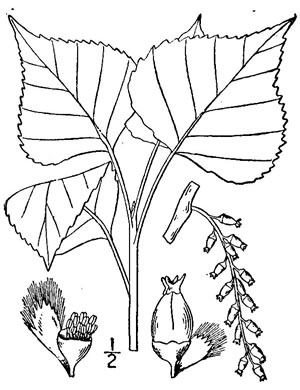Spermatophytes (seed plants): Angiosperms (flowering plants): Eudicots: Core Eudicots: Rosids: Fabids: Malpighiales
WEAKLEY'S FLORA OF THE SOUTHEASTERN US (4/14/23):
Populus nigra
FAMILY
Salicaceae
Go to FSUS key
Dig deeper at SERNEC, a consortium of southeastern herbaria.
Check out EDDMapS.org to see where this has been reported.
Read more about European Black Poplar at Vascular Plants of North Carolina.
SYNONYMOUS WITH
PLANTS NATIONAL DATABASE:
Populus nigra
FAMILY
Salicaceae
SYNONYMOUS WITH Flora of North America north of Mexico, vol. 7 (2010)
Populus nigra
INCLUDING Gray's Manual of Botany (Fernald, 1950)
Populus nigra var. italica
INCLUDING Gray's Manual of Botany (Fernald, 1950)
Populus nigra var. nigra
INCLUDING Manual of the Southeastern Flora (Small, 1933, 1938)
Populus italica
COMMON NAME:
European Black Poplar, Lombardy Poplar, Black Poplar
To see larger pictures, click or hover over the thumbnails.
WEAKLEY'S FLORA OF THE SOUTHEASTERN US (4/14/23):
Populus nigra
FAMILY
Salicaceae
SYNONYMOUS WITH
PLANTS NATIONAL DATABASE:
Populus nigra
FAMILY
Salicaceae
SYNONYMOUS WITH
Flora of North America north of Mexico, vol. 7
Populus nigra
INCLUDING
Gray's Manual of Botany (Fernald, 1950)
Populus nigra var. italica
INCLUDING
Gray's Manual of Botany (Fernald, 1950)
Populus nigra var. nigra
INCLUDING
Manual of the Southeastern Flora (Small, 1933, 1938)
Populus italica
If a search such as "Carex leptalea var. leptalea" doesn't deliver the results you want, try "Carex leptalea".
Or, to minimize chances of a misspelling, try just "Carex le".
Less is more: If "pencil flower" doesn't deliver the results you want, try "pencil".


